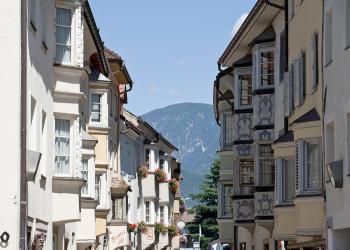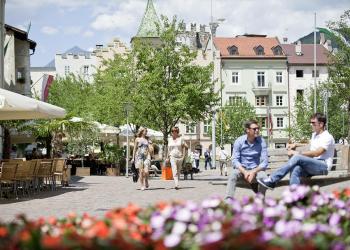Brixen / Bressanone in the Eisack / Isarco Valley is not only Tyrol's oldest city, but until 1806 was also the capital of a small ecclesiastical principality.
No matter how or from which side you approach Brixen / Bressanone, the two striking Baroque cathedral towers with their onion-shaped domes still dominate the city's skyline. Against this background, it's no wonder that one can find such a great range of cultural and historical monuments here.
The interior of the cathedral represents a unique symbiosis of German and Italian Baroque. Extravagantly, white Carrara marble, yellow Brentonico, red-brown Pfunder, and reddish brown Roccetta were employed in building it. And the list of Tyrolean artisans who created it is a veritable "Who's Who" of great craftsmen.
An artistic highlight is the cloister of the former cathedral, which is entered through a door on the right side of the foyer. With the exception of four vaults, the walls are all covered with frescoes from the 14th and 15th Century. One of the artists involved was the seemingly ubiquitous Hans von Bruneck. It is worthwhile to participate in a guided tour and learn more about the historical background and symbolism of these works of art.


When visiting the cathedral and cloister, one should definitely also take special note of the tomb of the famous warrior and minstrel Oswald von Wolkenstein on the adjacent site of the former cemetery. The entrance is on the left next to the cathedral entrance. The grave stone was made by the Tyrolean nobleman during his lifetime, and it can thus be assumed that his portrayal on it – as a tough, bearded warrior – reflected his actual wishes.
The former Hofburg recalls the city's glorious past as the seat of the Prince-Bishop. Before passing the main gate, observant visitors can still see just how financially strapped the Prince-Bishop was at the time. There are still clearly visible traces of the damage inflicted by rebellious peasants breaking down the door during the insurrection. There was simply no money available to repair the damage.
The acute shortage of money was also the reason why the courtyard displays the styles of different epochs. Due to the shortage of funds, it was possible to rebuild the former castle and convert it into a chateau only in stages. The showy interiors of the Hofburg – which today house the Diocesan Museum, the Cathedral and Nativity Museum – are a delight to behold.